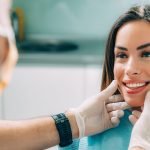There’s no doubt that brushing, flossing and using mouthwash as needed are three good habits to maintain, but how you accomplish them is just as important. When discussing these actions, many patients have different ideas on how to do it properly. At the Placerville Dental Group, we want to make sure that you’re getting the best protection possible through your oral hygiene routine. Therefore, let’s go over how to properly brush your teeth, use dental floss, and rinse with mouthwash.
How to Brush Your Teeth
First off, you’ll need the proper tools to do the job right. Your toothbrush should have soft bristles to prevent irritation of gum tissue or scraping away your enamel. Also, use toothpaste recommended by the ADA (American Dental Association). Since regular visits to the Placerville Dental Group keep your dentist up to date on your dental circumstances, feel free to ask us what toothpastes would be best for you. We may also have good advice on what toothbrushes to choose from.
While holding your toothbrush at a forty-five-degree angle along the gumline, brush the front and back surfaces of each tooth as well as the chewing surfaces. In the past, brushing back and forth along multiple teeth used to be the preferred style, but this method often misses much of the tooth. Instead, focus on each tooth individually using a circular motion — an electric toothbrush with an oscillating head makes it very easy.
When you’re done with the teeth themselves, brush the soft tissues including gums, cheeks, tongue, and roof of your mouth. Harmful bacteria latch on to all these surfaces, not just your teeth, so they all need brushing.
How to Floss
Take an eighteen to twenty-four-inch length of floss, and wrap the ends around the index and middle fingers of each hand. Make a u-shape with the floss and bring the shape around a single tooth, and gently go up and down along the sides. However, do not use a back and forth saw-like motion, especially near the gums, as this irritates the soft tissues and can cause bleeding.
You may also find interdental brushes useful. If you keep them clean and sanitized, they can be used on multiple occasions. Think of them as small toothbrushes for inbetween your teeth. They are especially helpful for patients with braces, and some sets are specifically designed for orthodontics. When using them, insert one into the space between the teeth and gently move it back and forth to trap plaque and food on the bristles. Be very careful when inserting the brush to not poke the gum.
How to Use Mouthwash
We offered a recent article with details on different kinds of mouthwashes, as well as how to use them properly, but here’s a summary of the instructions. Pour the recommended amount into your mouth, keeping your teeth slightly apart. Swish the liquid between your teeth for about thirty seconds, or the recommended time limit, usually no more than a minute. Carefully tilting your head helps relocate the mouthwash to reach your back molars, but be careful not to swallow it. Once you are done swishing, spit it out into your sink and rinse it down the drain, but don’t rinse your mouth. The mouthwash left behind is still doing its job. Refrain from eating or drinking for half an hour or so to get the full effects.
Of course, every mouth is different. What might work for one person’s oral health might not benefit another. Some people do not even need to use mouthwash on a regular basis. That’s why it’s important to see your dentist at the Placerville Dental Group at least twice a year. We inspect your oral health and make sure that both the tools and the methods you use are the best ones to maintain your teeth. If you have any questions about your current regimen, or would like to improve it, give us a call or schedule an appointment online. Once we verify the basics are in place, we can help you improve them so your smile will continue to shine.



0 Comments